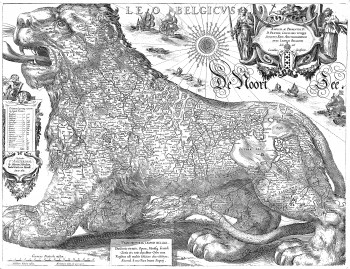
To view a larger image, please click here or hover over the photo above.
Author: Hondius
Year/Period: 1611
| Size: | Inches: | 32 x 24 |
| CM: | 80 x 60 |
Price: $699.99
SKU:
Other Images:
Description:
We remind you to refer to the artistic process shown on the left side or see the video available on the right side referring to the artistic process.
Leo Belgicus, Latin for Belgic Lion, is both a heraldic device and was a popular design of map of the Low Countries (the current day Netherlands, Luxembourg and Belgium) drawn in the shape of a lion.
The earliest Leo Belgicus was drawn by the Austrian cartographer Michael Aitzinger in 1583, when the Netherlands were fighting the Eighty Years' War for independence. The motif was inspired by the heraldic figure of the lion, occurring in the coats of arms of several of the Netherlands, namely: Brabant, Flanders, Frisia, Guelders, Hainout, Holland, Limburg, Luxembourg and Zeeland, as well as in those of William of Orange.
Aitzinger's map was the first of many. There were three different designs. In the most common one, the lion's head was located in the northeast of the country and the tail in the southeast. The most famous version is that of Claes Janszoon Visscher, which was published in 1609 on the occasion of the Twelve Years' Truce. A less common design reversed the position of the lion, as shown in the Leo Belgicus by Jodocus Hondius.
The third version was published in the later stages of the war, and after the independence of the Dutch Republic was confirmed in the Peace of Westphalia (1648). It is called the Leo Hollandicus, the Holland Lion, and shows only the province of Holland. One of the earliest versions was published by Visscher around 1625.
Although the name "Belgica" is now reserved for the Southern Netherlands ("Belgium"), before the division of the Low Countries into a southern and a northern half in the 16th century, the name referred to the entire Low Countries, and was the usual Latin translation of "the Netherlands" (which name then covered the current territory of the Netherlands, Luxembourg, Belgium and a small part of northern France).
Engraving Information:
This artistic reproduction of a vintage map was made using modern graphic procedures, but obtaining the results found in the antique copperplate engraving technique, as one can easily find out by lightly rubbing his/her finger on the map. This map, which is an exact reproduction of the original antique, is printed on cotton paper panels which are glued and mounted on a cotton cloth background "a stacchi" (slightly separated from each other), in order to allow for folding and easier transport. Finally, map is water-colored by hand making it a truly unique piece, worthy of the original old print.
Useful Links (provided by Wikipedia):
Useful Link 1






